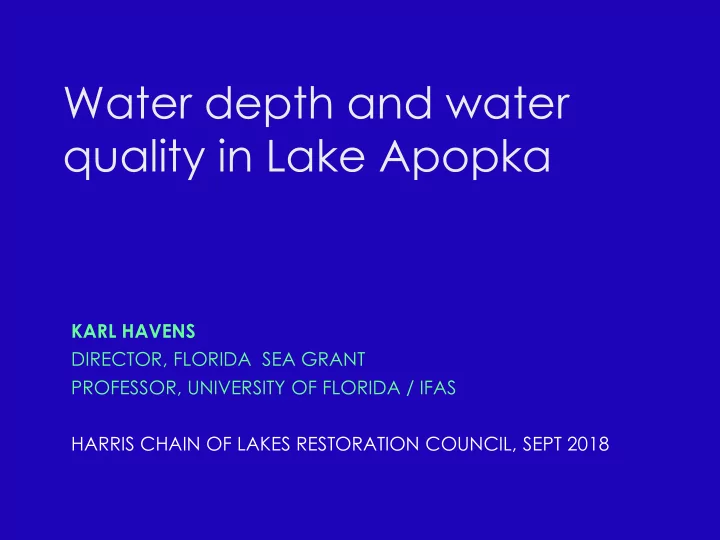

Water depth and water quality in Lake Apopka KARL HAVENS DIRECTOR, FLORIDA SEA GRANT PROFESSOR, UNIVERSITY OF FLORIDA / IFAS HARRIS CHAIN OF LAKES RESTORATION COUNCIL, SEPT 2018
• 1999-2016 SJRWMD data from Harris Chain • Intent: determine if variation in depth can affect limnology of shallow FL lakes • Dataset originally used to examine zooplankton and phytoplankton • First, all Harris Chain lakes, then focus on Apopka • Study was not a test of efficacy of restoration program; it was a case study of climate variability effects
Havens, Ji, Beaver, Fulton et al. (2017) Hydrobiologia
Based on 1999-2016 data from the SJRWMD
Havens and Ji (2018) Inland Waters
Havens and Ji (2018) Inland Waters
Conclusions 1: Droughts and extreme low water resulted in markedly reduced water quality in Lake Apopka during 1999-2016, as well as in the other Harris Chain of Lakes. Similar results have been obtained in other shallow lakes world-wide
Drought Depth and Volume Decline Fish, nutrients and algae are concentrated / fish effects are magnified Blooms more severe
Wet Years Depth and Volume Increase Fish, nutrients and algae are diluted / fish effects are weakened Blooms less severe
A Longer Historical Context With additional data provided by the SJRWMD from the onset of routine water quality monitoring in 1985
Mann-Kendall non-parametric trend tests Start: 230 End: 113 Change: 51% down Significant: yes, <0.001 Start: 5.6 End: 4.2 Change: 26% down Significant? Yes, <0.001
Start: 101 End: 56 Change: 44% down Significant: yes, <0.001 Start: 0.22 End: 0.33 Change: 54% up Significant: yes, <0.001
Last three values significantly lower, and by 40%
Last three values significantly lower, and by 58%
Last three values significantly lower, and by 32%
Last three values significantly higher, and by 73%
Conclusions 2: Statistically-significant long-term declines in TP, TN and Chl-a in the 1985-2018 dataset, and increased Secchi depth Comparing high water periods only, improved water quality during last three high water periods compared to earlier high water period. Reiterating – severe lows are a problem. Why are they happening?
Thank you
Recommend
More recommend